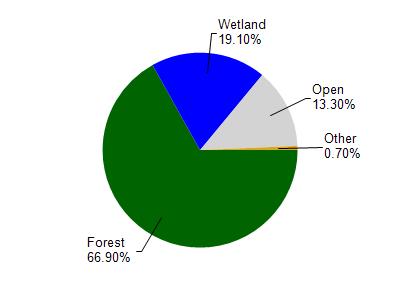Vilas
No
No
No
Fish and Aquatic Life
Overview
Crystal Lake (T41n R07e S27), in the Manitowish River Watershed, is a 92.64 acre lake that falls in Vilas County. This lake is an outstanding/exceptional resource water under NR102 under the Fisheries Program. This lake is managed for fishing and swimming and is currently not considered impaired.
Date 2011
Author Aquatic Biologist
Historical Description
Source: 1963, Surface Water Resources of Vilas County Crystal Lake, T-41-N, R-7-E, Sections 27 and 28, Area = 90 Surface Acres, Maximum Depth = 69 feet, S.D.F. = 1.11.
This is an extremely infertile seepage lake. It has acid, clear water of very high transparency. The bottom consists mainly of sand with some gravel also present. The lake has a history of scientific study as an example of extreme infertility. The physical-chemical characteristics of this body dictate that it should be managed as a trout water. Presently, the lake contains both kamloops trout and the hybrid trout splake, both experimental introductions. A relict population of lake trout also exists in the lake. As a result of the clear water and the sandy bottom, the lake is a great favorite with swimmers. Public use opportunities are excellent on this lake. There is public access by county highway as well as through the state park area and the state campgrounds which is located on the lake. A town ordinance presently prohibits boats with motors on this lake. The lake is one of the most heavily used waters in the area. Canoeists, swimmers, skin divers, sailboaters and campers exert a continual use pressure on this water from late May to early September.
Date 1963
Author Surface Water Inventory Of Wisconsin
General Condition
Crystal Lake Campground Beach Right and Left were assessed for the 2018 listing cycle; E. coli data sample data were clearly below the 2018 WisCALM listing thresholds for the Recreation use. These waters were not meeting their designated uses and not considered impaired.
Date 2017
Author Ashley Beranek
Condition
Wisconsin has over 84,000 miles of streams, 15,000 lakes and milllions of acres of wetlands. Assessing the condition of this vast amount of water is challenging. The state's water monitoring program uses a media-based, cross-program approach to analyze water condition. An updated monitoring strategy (2015-2020) is now available. Compliance with Clean Water Act fishable, swimmable standards are located in the Executive Summary of Water Condition in 2018. See also the 'monitoring and projects' tab.
Reports
Recommendations
Aquatic Invasives Research
UNIVERSITY OF WISCONSIN-MADISON: Whole Lake Mixing to Remove Invasive Rainbow Smelt in Crystal Lake: final phase. Build Gradual Entrainment Lake Interters and mixing system and mix lake for 3 years
Management Goals
Wisconsin's Water Quality Standards provide qualitative and quantitative goals for waters that are protective of Fishable, Swimmable conditions [Learn more]. Waters that do not meet water quality standards are considered impaired and restoration actions are planned and carried out until the water is once again fishable and swimmable
Management goals can include creation or implementation of a Total Maximum Daily Load analysis, a Nine Key Element Plan, or other restoration work, education and outreach and more. If specific recommendations exist for this water, they will be displayed below online.
Monitoring
Monitoring the condition of a river, stream, or lake includes gathering physical, chemical, biological, and habitat data. Comprehensive studies often gather all these parameters in great detail, while lighter assessment events will involve sampling physical, chemical and biological data such as macroinvertebrates. Aquatic macroinvertebrates and fish communities integrate watershed or catchment condition, providing great insight into overall ecosystem health. Chemical and habitat parameters tell researchers more about human induced problems including contaminated runoff, point source dischargers, or habitat issues that foster or limit the potential of aquatic communities to thrive in a given area. Wisconsin's Water Monitoring Strategy was recenty updated.
Grants and Management Projects
Monitoring Projects
| WBIC | Official Waterbody Name | Station ID | Station Name | Earliest Fieldwork Date | Latest Fieldwork Date | View Station | View Data |
|---|
| 1842400 | Crystal Lake | 10006233 | Crystal Lake | 7/27/1999 | 9/30/2017 | Map | Data |
| 1842400 | Crystal Lake | 643633 | Crystal Lake Beach - Right | 6/27/2001 | 8/11/2025 | Map | Data |
| 1842400 | Crystal Lake | 10021741 | Crystal Lake - J | 8/6/2007 | 8/6/2007 | Map | Data |
| 1842400 | Crystal Lake | 10021732 | Crystal Lake - A | 8/6/2007 | 8/6/2007 | Map | Data |
|

Watershed Characteristics
Crystal Lake is located in the Manitowish River watershed which is 268.60 mi². Land use in the watershed is primarily forest (66.90%), wetland (19.10%) and a mix of open (13.30%) and other uses (0.70%). This watershed has 212.08 stream miles, 22,943.16 lake acres and 33,727.48 wetland acres.
Nonpoint Source Characteristics
This watershed is ranked Low for runoff impacts on streams, Low for runoff impacts on lakes and Low for runoff impacts on groundwater and therefore has an overall rank of Low. This value can be used in ranking the watershed or individual waterbodies for grant funding under state and county programs.However, all waters are affected by diffuse pollutant sources regardless of initial water quality. Applications for specific runoff projects under state or county grant programs may be pursued. For more information, go to surface water program grants.